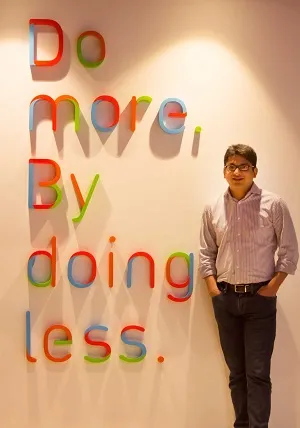Helpchat 3.0 - how the anti-chat philosophy is helping the company gain 22,000 transactions per day, with a GMV of $10M monthly
“It involved a lot of sleepless nights. We suddenly went from being a high-growth company to having to go back and refigure things,” he says.
We ask, “What was the most difficult part?”
“Convincing myself,” he retorts.
After making the difficult decision to pivot the company into a chat-based personal assistant, and shifting the entire team (along with their families) to a new city, Ankur Singla, Founder, Helpchat (formerly Akosha) realised the chat-based model wasn’t working. The stakes were high this time.
“We had to make some difficult personal choices. So much so that I had to write down things to get them off my head,” he continues.

The past year really brought out the best in Ankur Singla, forcing him to charter untested waters, a time he says was filled with anxiety and unsurety.
Version 2.0 - Metamorphosis – The journey
Flashback to March 2015.
At this point, Helpchat was trying to evolve its business model, transforming into a personal chat assistant for millions of Indians. In its earlier avatar as Akosha, it was a complaint-resolution platform against large companies that helped people solve grievances through their B2B product.
But why the pivot?
“We got seduced by the idea that chat is going to be the next UI,” says Ankur.
Ankur further adds that when Aksoha started their phone helpline, they got more questions and queries than complaints.
At the time, media reports had surfaced of Haptik (another instant messaging personal assistant) accusing Akosha (Helpchat) of cloning their app.
But Ankur Singla had more important things to deal with. The transition was underway.
Although it was a daunting task to pivot, Ankur was clear that there was no scope for any kind of second guessing. The senior staff at Helpchat were also expected to communicate this confidence.
Second, management realised that the next big scaling up will come via technology, and shifting headquarters to Bengaluru. They shifted 35-40 of their most critical employees and techies from Delhi to Bengaluru, and a crack team of six people was created, whose job it was to just learn the different nuances of building a transactions company.
In May, Helpchat secured Series B funding of Rs 100 crore from Sequoia Capital and Runet. By July, they were doing 50,000 chat sessions a day.
However, right when things seemed to catch fire, the team hit another roadblock – users who were chatting were never coming back. Suddenly, the premise on which they had banked the whole company wasn’t giving them the same kind of returns anymore.
“All the things, which are not ideal for building a company, were happening”, adds Ankur

Version 3.0 – putting product learning into place
The team at Helpchat chose to step up and say the real challenge was the chat format itself.
The strategy changed to adopt the best tool approach. The learning was that while chat was good, it was not for everything. Whether it is a ‘two-click booking’ for cabs or a little text for laundry services, the team decided that chat will be used only where relevant.
The next move was to link the attributes of the app with that of a personal secretary, including tasks like getting chores done rather than doing it themselves; doing multiple things at a time with diligence and feedback; checking if everything is done on time; and whether the user was happy with the experience.
Next came the choice of which vertical to build first. The team was extremely clear that their focus would be on use cases, based on their popularity.
Hence, cab bookings, deals, and recharges became the first verticals to be built and scaled up.
Ankur says,
You have to build all the use-cases since you are a horizontal platform but what you choose to build first can change the journey you go through in the future.
The third was to take a hard call of being a pure play platform, and not divide the business into verticals. Helpchat had initially made this mistake by entering into groceries. The fourth involved customer stickiness. If a better experience had to be created, Helpchat had to get the customer to keep the app for a certain time. Therefore, on day zero, the app needed to make certain actions related to retention, which was essential.
Through October, November, and December, Helpchat stopped all its marketing efforts and rebuilt the entire product, only to launch a newer version in January.
Version 3.0 – Helpchat, your true virtual assistant

“We just realised that the amount of time a person takes to do a transaction on chat is around 10x longer than just clicking things. We ourselves were not using the app,” adds Ankur.
That’s what brought on the following changes:
The Homescreen
Just like Google Now, Helpchat’s homescreen greets the user from the minute he or she wakes up with news and the horoscope on top. By 8:30 – 9 am, this changes with suggestions for cab bookings and traffic routes and switches to lunch options by noon.
But the founders tell us that the only difference from Google Now is that HelpChat wants to complete the transaction on their platform without ever having to go to other apps. The Artificial Intelligence (AI) is further used to create multiple predictive cards for customers based on the information collected from the user.
The Next Screen: Explore
Broken into grids, every section handles different capabilities. For example, for recharges through messages, the platform recognises whether the user has paid his bill or not. Over the next 15 days, users can expect a data card sitting on the main home screen telling them about their usage, and suggesting a suitable recharge plan.
The AI strategy
The functioning of the platform is linked to their machine learning algorithm, which facilitates prediction. Capturing 3 million data points every day, spread across 100,000 daily users, the platform also uses NLP (Natural Language Processing).
For Ankur, the exciting thing about AI is the prediction, which finds different ways for customers to use their product.
The platform creates a personal identity of the user from the information transmitted by the OS, including their apps, and the version of the phone etc. With user permission, it collects location, calendars, and e-mail while browsing through data. Other sources include browsing patterns (on Helpchat), creating a full identity for the users, and launching predictions, accordingly.
Currently, the platform captures 30 to 40 percent of this information, with expectations to grow it to 80 percent in the next one year.
“Machine Learning is the over-arching technology that will cover everything. We will have to do NLP, not on chat but content, to understand nuances and give you preferences. There is also an active play of sentiment analysis, which depicts a user’s mood at a particular time of the day. This is based on their reading history and search history.” says Ankur.

The traction
With more than 2 million downloads across platforms, Helpchat, at present, does 22,000 transactions a day. Breaking down that number translates to 5.4 transactions on an average, per user, in a month. These numbers translate to 122222 active users per month which is surprising for an app claiming 2 million downloads(at less than 10 percent engagement/retention).
Over 100,000 AI-powered predictive cards are generated daily for users with 40+ brand partners on the platform. Having a GMV of $8-10 million at present, the firm plans to bump this number up to $80 million by March 2017.
Currently operating in metros like Bengaluru, Delhi, Mumbai and Hyderabad, the firm is planning to raise another round of investment in the coming months.
Helpchat acquired hyperlocal delivery platform, Niffler in September 2015 to accelerate the growth of its personal assistant engine across the areas of offline commerce and local deals based on user intent.
Transactions – a business
Having oriented themselves to the partnership model, Helpchat charges partners per transaction. Depending on industry standards, the firm charges 4-11 percent per transaction.
Just like any affiliate model, there are basic take rates, new user acquisition, take away bounties for having reached a certain number of transactions, which add to the revenue.
The firm also has co-promotions going on with certain firms, which further adds to their kitty. In total, there are seven different categories live on Helpchat including Utilities, Cabs, Food, and Recharges, and in the next 15 days, customers can also pay their electricity and gas bills through the platform.
However, it still remains to be seen how Helpchat’s new platform fares with users. But, for now, a rather relaxed and happy Ankur says,
Our product at this stage gives us a lot of confidence. If we wouldn’t have made the decision which we have made today, we might have got lost considering the high noise levels in the market.
Website: www.helpchat.in







